“The army is mostly made up of idle and idle types. Without the constant supervision of the commander, this machine quickly disintegrates "- said Frederick the Great. And indeed - out of concern for the army, this philosopher-king and ruthless perfectionist made his soldiers more afraid of their officers than of clashes with the enemy ...
While the Prussian ruler was famous for his strict military discipline, he was no exception in his conduct. Such behavior can be observed in all of his contemporary European armies. According to historian John Lynn, the style of warfare used at the time was based on the belief that an ordinary soldier was trained, but he was not trusted. And it didn't matter if he was a volunteer or a conscripted soldier - everyone was treated like a potential defector.

The patterns of strict Roman discipline and corporal punishment related to its maintenance must have made a considerable impression on posterity.
Thus, in order to get him out of his head even the thought of leaving the ranks, apart from typically military training, great importance was attached to maintaining discipline. Fr. Wellington used to say, "I don't know how you can even have an army if you don't keep discipline in it." Moreover, Napoleon's conqueror was convinced that order in the army could not be maintained without punishment. "And there is no punishment that would make such an impression [...] as corporal punishment," he wrote years later.
A role model
According to military historians, the concept of strict discipline (including corporal punishment) emerged as a result of changes in the modern battlefield - where the foot soldiers took the lead. As the researcher of the topic, Elżbieta Olzacka points out, infantry was more and more effective in clashes with knightly cavalry not because of modern weapons, but a new organization of combat. And he gives an excellent example of Swiss troops of free highlanders, who "broke the monopoly of driving for military victories equipped with weapons as lowly sophisticated as a halberd or pique".
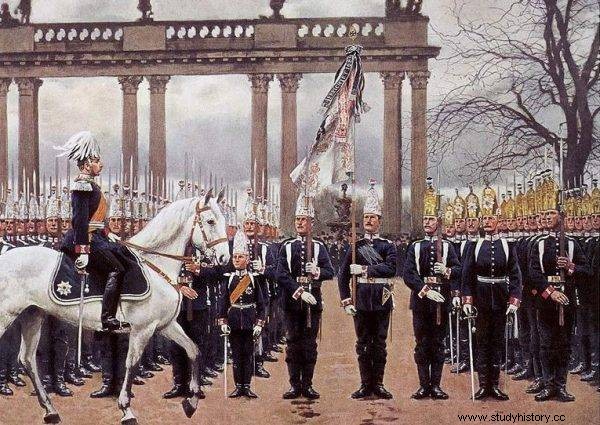
“The army is mostly made up of idle and idle types. Without the constant supervision of the commander, this machine quickly disintegrates "- said Frederick the Great.
The necessity to stand up to heavy chivalry "prompted them to preserve or restore the ancient military organization, without which, as any reasonable man would admit, infantry is utterly useless," wrote Niccolò Machiavelli, advocating military reforms. And although it is difficult to imagine Swiss highlanders studying ancient military treatises, according to Olzacka, "the next generation of military reformers used them consciously." And the models of strict Roman discipline and corporal punishment related to its maintenance must have made a considerable impression on posterity .
The commanders of the legions had the power of life and death over their soldiers, and summary executions by beheading with a sword or an ax were nothing extraordinary. Tomasz Szeląg, a researcher of punishments in the Roman army, also notes that corporal punishment was also often treated as a mitigation of the death sentence for the most serious offenses against military discipline. This was the case, for example, with the cutting of hands used for desertion, espionage or theft.
Whip on the rebellious
Legionnaires could also, at best (apart from fines, expulsion from service, degradation, cutting off their food rations or forcing themselves to eat raw barley that is extremely painful for the intestines), be punished with whipping. And they were flogged for insubordination, cowardice and unmanly behavior. The Greek historian Polybius states that:
also whips the one who stole something in the camp; also what he gave false testimony; further, if any of the young people are caught fiddling with the body; and finally the one who was fined three times for the same guilt .
It should be noted that the whipping itself could have a lighter or more bloody dimension. The guilty party was often beaten with a flagrum - a whip with a few straps ended with hooks. It does not take a great deal of imagination to visualize the effect of this tearing body part of the torture .
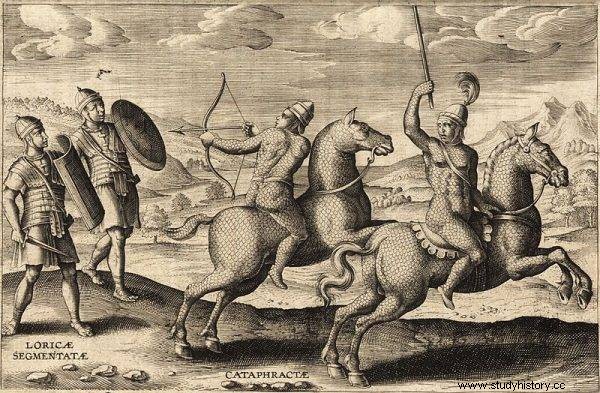
There was iron discipline in the Roman army
Deserters (caught, of course) were sentenced to the fustuarium, that is, beaten with heavy truncheons in front of the unit, which had been exposed as a result of a guilty crime. In the rare cases where a convict has experienced such a torment, the padding did not stop there. The battered and barely alive unfortunate man was expelled from the army. Fustuarium or stoning was waiting - recalls Polibius, invaluable in his arguments:
likewise, if someone is placed at the post, he leaves the indicated place out of fear; and likewise, if in the midst of the struggle itself, he discards something of his weapon out of fear. Therefore some in their positions risk obvious death when a much larger enemy presses against them, not wanting to leave the formation for fear of punishment In the camp. And some, having lost their shield, sword, or other part of their weapon in combat, as madmen attack their enemies in the hope that they will either regain what they have lost or, by dying, avoid the infallible disgrace and insult of their comrades .
Decimated legions
For treason, a soldier could also be sewn into a sack with poisonous snakes, and then thrown into the river. An example of an extremely brutal punishment against a legionnaire for raping the wife of a Roman citizen is also cited. The soldier was tied to two young trees bent to each other. When the trunks were released, the condemned man was torn in two.
Vegetius, the author of the only fully preserved Roman textbook on the art of war of his time, stated that "[...] the Roman nation conquered the whole world only thanks to the training of its troops, discipline and skill obozowej ", and hardly anything is so strongly associated with the severity of Roman military life as decimatio .
It was a form of extremely cruel punishment applied to a cowardly or rebellious group of soldiers. The unit condemned to decimation was divided into groups of ten. From each of them, one unfortunate was selected at random, most often killed by beheading or beating to death by his companions. The sentences were executed immediately, irrespective of the rank of the victim, reputation or even involvement in the crime in question.
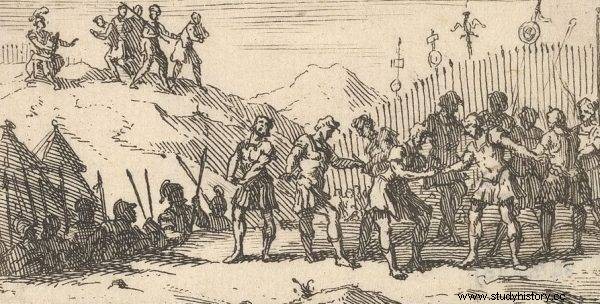
There is little that is so strongly associated with the severity of Roman military life as decimatio.
Contrary to popular belief, however, decimation was not a common punishment. On the one hand, it was probably due to the lack of frequent reasons for its use, and on the other hand, those cases that already took place resulted in a severe reduction in the personal status of the legions. It was also not without significance that the army's morale was weakened (although the decimation was supposed to raise them), so it was ordered only in exceptional circumstances. Nevertheless, at least one of the Roman emperors went way too far in this practice.
At the end of the third century, on the orders of Emperor Maximian, the so-called Theban legion (the name comes from Thebais in Upper Egypt, where this unit was created from among the Egyptian Copts). After carrying out the bloody sentence, the squad once again defied their orders and was subjected to another round of decimatio . The situation repeated, until all 6,600 (it is also said that there were 6,666) soldiers of the rebellious legion were finally killed. Among the victims of the martyr's martyrdom was also one of the commanders of Mauritius, later known as St. Maurice - owner of the famous Spear of Destiny.
The practice of decimation did not die with the Romans. Commanders throughout history up to the 20th century revived this bloody tradition as a punitive and disciplinary measure.
Whipping is good for everything
The Royal Navy has always been known for its strict discipline - and for good reason. Since many sailors were forced to serve or chose this profession out of necessity, it took a hard hand to control this jumble of sometimes suspicious individuals.
Most of the disciplinary regulations and related penalties were listed in those written in the middle of the XVII century and articles of war updated over the years. Every week, the crews of all British ships, from the largest liners to the smallest sloops, gathered on the decks to hear the list of offenses and the corresponding penalties from the lips of the commanders. The tedious ritual, however, made it impossible for any of the sailors to deny their knowledge of the rules.
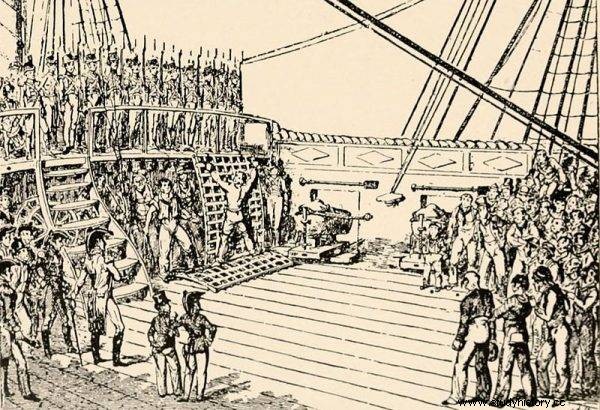
While death was the penalty for serious crimes, flogging was the most common for smaller crimes.
While death was the penalty for serious crimes, flogging was the most common for smaller crimes. Superiors in the Royal Navy were particularly fond of this kind of punishment. It actually threatened for any deviation from the regulations, and even without it, it was willingly applied . Consequently, fear of her was common. Moreover, in the navy, which did not complain about the excess of personnel, flogging did not permanently eliminate the convicts (although such cases also happened), allowing them to continue their service.
The cat with nine tails
The most frequently used instrument of execution was the so-called nine-tailed cat - a whip consisting of nine waxed cords with knots at the course and end of each strand. Each of them usually stuck in the victim, tearing the skin and causing profuse bleeding. As if that was not enough, after taking the recommended number of times (e.g. from 200 for desertion to 500 for theft), the unfortunate man's back was poured with sea water - allegedly to cleanse his wounds. However, it was just another torture and, according to the researcher of the subject Barry Pickthall, it has become a permanent part of the canon of practices that further increase the suffering of the inmates.
Various variations of the punishment were invented to vary the punishment used. One of them, considered by some to be the strictest, was the so-called flogging around the fleet. According to its rules, the number of times awarded was divided by the number of ships in a given port. Then the convict was transported in a small boat to individual units, where he either boarded them himself and received the appropriate strings or members of the crews came down to it and performed the ordered execution. Everything took place under the supervision of a surgeon and if the surgeon decided that the convict was no longer able to take the awarded number of strokes, he interrupted the execution of the sentence.
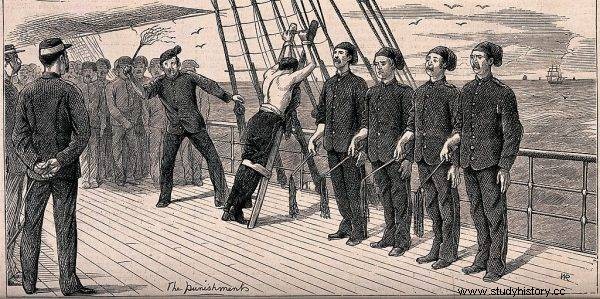
In the case of a greater number of ordered times (e.g. 1000), it could take months to enforce them
However, anyone who thought that it ended there would be wrong. As soon as the unfortunate man recovered, the execution of the sentence continued. Therefore in the case of a larger number of ordered times (e.g. 1000), their enforcement could take months or even - as Pickthall writes - years.
For a long time, the brutality of punishments was outdone, although at the beginning of the 19th century it was recommended to limit the number of cat hits to a dozen or so. However, it was not until 1879 that the use of corporal punishment was completely banned, and perhaps the last such case in the Royal Navy was recorded three years later.
A ball and chain
The introduction of discipline was a real challenge for both Union and Confederate commanders during the Civil War. At the beginning of the conflict, neither side had a virtually professional army. On the other hand, during the operations, mainly volunteers and conscripts were used, for whom the harsh life of a soldier was something completely new and often difficult to bear.
Accordingly, the most common offenses were insubordination, simulating disease, neglect of duty, desertion and cowardice . While formal military courts were rarely called and were often rather sluggish, commanders in the field were empowered to administer justice as they saw fit. And although flogging was abolished in the US military before the war, there were still many unpleasant corporal punishment methods to choose from.

US Army firing squad kills deserters during the Civil War.
In order to bring unruly soldiers to order, among others, the humiliating and painful punishment of gagging. However, it was not just closing her mouth (with a wooden rod - similar to a horse's bit). The condemned man had to sit for a long time with his knees drawn to his chest and his hands tied to his ankles. In addition, a stick was inserted between the elbows and bent knees, which effectively prevented any change of position.
To this day, in many armies of the world it is used to carry heavy logs during strength and endurance training. But during the Civil War, wearing a wooden ballast over your head was a form of punishment. The condemned man had to carry his burden alone all over the camp until he collapsed from exhaustion.
There was also an order to walk with a cannonball chained to the leg, to stand on a barrel for hours, or to walk around the camp in it. For worse offenses, they were sentenced to be stretched out on a cannon wheel and half of the poverty, if the unfortunate man was stretched out in an upright position. If the offense was of the heavier type, and the commander was a fantasy man, then the wheel was turned to make the condemned person suffer even more horizontally or upside down.
Spanish donkey
According to Tahlia Y. Burton, a researcher of penalties in the US military, the punishment of burning with a hot iron - most often on the forehead - was not so much painful as stigmatizing - the first letter of the name of the crime committed . The slang from the cattle branding practice in the Wild West acted as an enormous deterrent to many soldiers.
One of the most elaborate and painful punishments, however, was the so-called riding a wooden mule. It was a form of torment known for a long time as the Spanish donkey, for example from the ordinance of military courts in the times of our Jan Kazimierz.
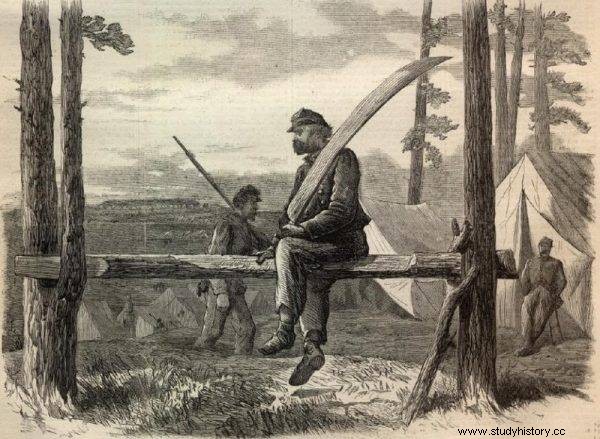
One of the most elaborate and painful punishments, however, was the so-called riding a wooden mule. It was a form of torment known for a long time as the Spanish donkey.
For the needs of the New World, only a new name was invented - because the idea of action was the same. The condemned man was seated on the narrow side of the board (or the edge of a triangular box), which was placed high enough so that the poor man's feet would not touch the ground. In order to increase the pressure on the board and intensify the terrible sensations of this often long "ride", additional weight was attached to the victim's feet and the "seat" itself was serrated. The result was terrible perineal injuries and only the loss of consciousness saved from worse consequences.
For more serious crimes, such as desertion, the penalty was shooting. However, it turns out that despite the large number of desertions recorded during the Civil War, there were likely to be fewer than 200 executions, which would indicate a reluctance to resort to this kind of discipline.
